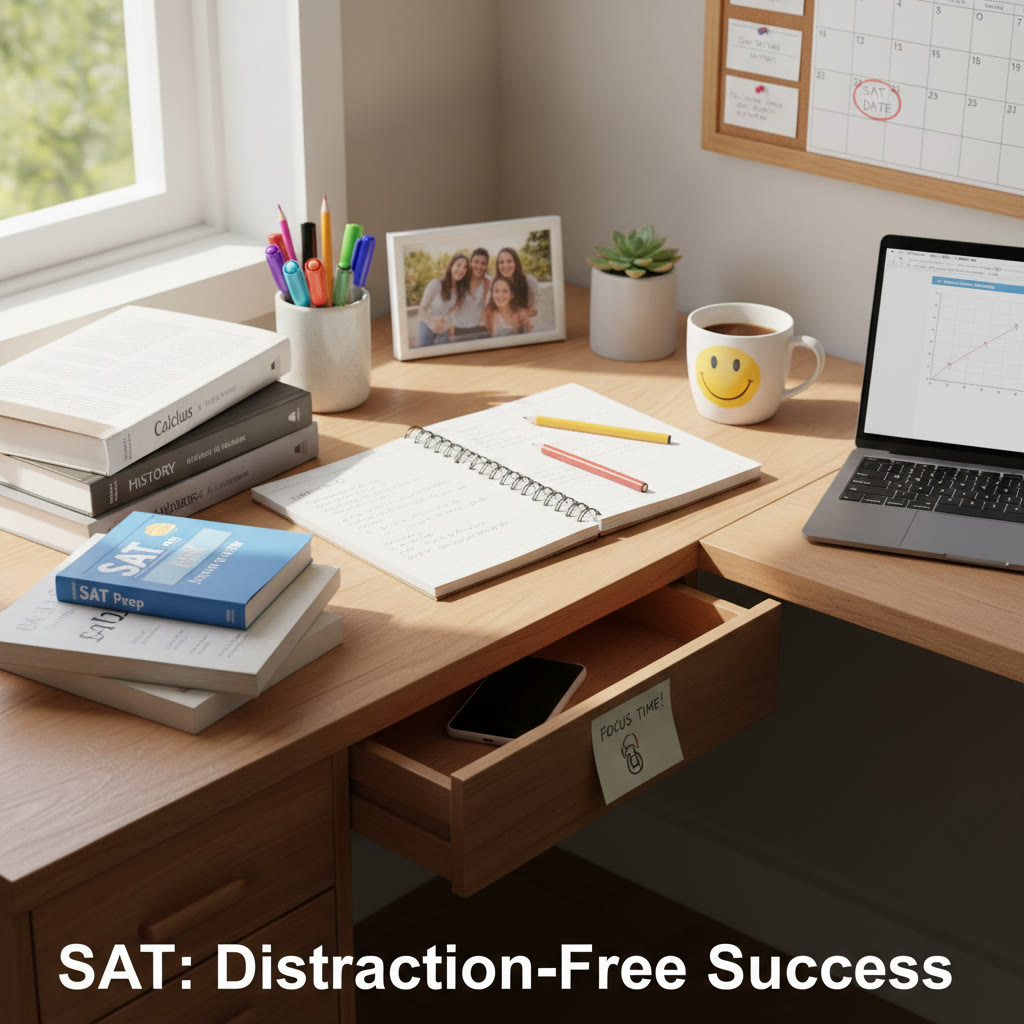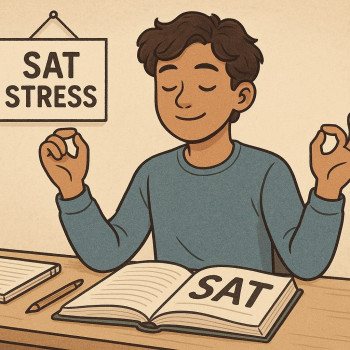Why Staying Off Social Media Matters More Than You Think
We all know the story: you open Instagram for a minute, three minutes turns into thirty, and suddenly you remember a question you had about algebra an hour ago. Preparing for the SAT asks for sustained attention—reading complex passages, holding multiple steps of algebra in your head, and writing with clarity. Social media steals the single most valuable resource for these tasks: attention.
But this post is not about making you feel guilty. It’s about giving you practical tools so you can choose when to use your phone, rather than letting it choose you. These are methods students actually use—small, human, and effective—and when combined with focused practice, they can make a real difference on test day.

The science in plain English
Each time you switch from studying to checking a feed, your brain pays a cost. Psychologists call it context switching. It takes time to get back into the exact mental state you were in, and that erodes the deep practice the SAT rewards. Add in the dopamine spikes from likes and notifications and you have a recipe for shallow, interrupted study sessions.
The real cost: hours, not minutes
Think in hours, not minutes. Cutting 30 minutes of casual scrolling each day saves you 3.5 hours a week. Over a typical 8-week SAT prep period, that’s almost 30 hours—enough for several full practice tests or targeted content review. Those hours compound into deeper learning and exam readiness.
Set a Compass: Your Why and Your Measurement
Start with a clear and personal reason
“Because I need a higher score” sounds sensible but feels abstract when your phone buzzes. Make your why vivid. Maybe it’s getting into a particular major, avoiding retaking the SAT, or proving to yourself that you can finish a challenging goal. Write it down, and keep it where you study.
Measure, don’t guess
Before you implement rules, find your baseline. Look at your phone’s screen time for the last week. How many minutes are actually spent on social apps? Writing the number down turns a vague feeling into a concrete target. From there, design realistic reductions—slow and consistent beats dramatic and unsustainable.
Practical Strategies to Stay Off Social Media
1. Small experiments: try short trials
Instead of “I’m quitting social media,” try 24-hour, 3-day, or one-week experiments. Frame each as a curiosity: what does my energy and concentration feel like without social feeds for three days? This is a low-pressure way to discover what works.
2. Design your environment
It’s easier to avoid temptation than to resist it. Try these environment tweaks:
- Keep your phone in another room during study blocks.
- Use a physical timer instead of your phone to time sessions.
- Create a study-only space that cues focus—clean desk, good light, water bottle.
3. Build rituals that replace checking
Rituals reduce decision fatigue. Before each study block, do a two-step ritual: 1) set your goal for the block (for example, “finish one Math section and review mistakes”), 2) do one physical cue like making tea or a five-second desk clear. The ritual primes your brain and replaces the reflex to reach for your phone.
4. Use tech to limit tech
Irony accepted: your phone can help you ignore your phone. Use built-in screen time limits to set daily allowances for social apps or schedule downtimes. For many students, setting a 60–90 minute social media allowance per day feels balanced, reducing guilt while protecting study time.
5. Commit publicly in a small way
Tell one or two people: a friend, parent, or a tutor. Even a quick message—”I’ll be off social media during XYZ study hours”—creates accountability. If you prefer guided accountability, Sparkl’s personalized tutoring can provide 1-on-1 guidance and tailored study plans that include accountability checkpoints, which many students find helpful when they’re trying to break a habit.
6. Replace scrolling with short, nourishing breaks
Breaks are crucial. The goal is not to be on your phone but to refresh your brain. Try these instead:
- 5–10 minute walk or stretch
- Quick mindful breathing or 2-minute journaling
- A snack and a glass of water while standing
Concrete Schedules and Examples
A sample study day that keeps social media out
Imagine a high school student, Maya, juggling school, soccer, and SAT prep. Her day looks like this:
- 6:30 am — Quick review flashcards (30 minutes) with phone in airplane mode
- 8:00–3:00 pm — School (phones away during class)
- 4:00–6:00 pm — Practice test section (50 minutes) + 10 minute break (no social apps)
- 7:30–8:30 pm — Targeted math review using mistakes from the practice section
- 9:00 pm — 30 minutes leisure, of which only 15 minutes is allowed for social media
Notice the key idea: social media is not banned forever, it is scheduled. That reduces fear of missing out and makes it easier to follow the plan.
Pomodoro with better breaks
Try a 50/10 or 45/15 rhythm for deep SAT work. In a 50/10 schedule, you do 50 minutes of focused study followed by a 10-minute break. On break, commit to moving—stand up, walk, hydrate. If you want a checklist for each focus block, try:
- Goal: one practice passage or a set number of problems
- Tools: timer, notebook, calculator (if math), pencils
- Post-block: log what you completed and one specific improvement to make next time
A 6-Week Social Media Reduction Plan (Table)
| Week | Daily Social Media Time | Focus Goal per Day | Notes |
|---|---|---|---|
| Week 1 | Baseline (record only) | 30 minutes of SAT-focused practice | Track current usage without changing habits |
| Week 2 | Reduce by 20% | 1 hour targeted review | Try one 24-hour no-social experiment |
| Week 3 | Reduce by 40% | 1.5 hours practice + one full-length section | Use app limits and study-only space |
| Week 4 | Reduce by 60% | 2 hours targeted practice | Schedule social media into a short evening window |
| Week 5 | Reduce by 80% | 2.5 hours practice including timed sections | Consider seeking additional guidance if struggling |
| Week 6 | Minimal: 15–30 minutes | Full-length practice test and review | Test-simulation mode; keep phone away during the test |
This table is a template. If your baseline is very high, move more slowly. If your baseline is already low, fine-tune the hours for intense review. The point is steady progress, not punishment.
Common Pitfalls and How to Outsmart Them
Pitfall: Willpower is a sprint, not a marathon
Willpower alone rarely sustains change. That’s why environmental design and small experiments work better. You’re less likely to open an app you can’t see, and rituals reduce the need to decide in the moment.
Pitfall: FOMO and loneliness
FOMO is real, especially senior year when everyone seems to be documenting college decisions. Counter this by scheduling connection into your life. A weekly call with a friend, a shared study session, or a quick text thread about college essays gives you social contact without endless scrolling.
Pitfall: “Just one more video” trap
One video almost always becomes many. A quick trick is to set a micro-commitment: decide you will watch exactly one video and then put a timer for its length. When the timer stops, close the app. Over time, this strengthens the habit of controlled consumption.
How to Use Social Media Smartly, Not Stupidly
Turn passive scrolling into active learning
Not all social media is wasted time. Use it deliberately: follow accounts that post SAT strategy, motivational study clips, or explanation videos for tricky math topics, and schedule a specific 15–30 minute window for that content. Afterward, immediately apply one concept to practice problems so the time becomes useful, not numbing.
Set an intention before you open an app
Ask: What will I do in the next five minutes? If your answer is vague, step away. If it’s specific—review one concept, save a link, ask one question—then use the small time window and stop when you’re done.
Accountability, Rewards, and Tracking Progress
Make progress visible
Keep a simple log: what you studied, time spent, and one takeaway. Visible progress is motivating and also helps with retrospective analysis—where are you improving, what still confuses you?
Use rewards strategically
Rewards can be small and immediate. After a week of sticking to your planned social media limits, treat yourself to a movie night or a favorite meal. Bigger rewards—like a weekend without studying—can follow bigger milestones, such as a score improvement on a practice test.
Get human help when needed
Sometimes the habit-change challenge is also an academic one. If you find that removing social media reveals gaps in content knowledge or practice strategy, consider guided help. Sparkl’s personalized tutoring offers expert tutors, 1-on-1 guidance, tailored study plans, and AI-driven insights to identify weak areas and keep you accountable—especially useful when breaking distraction habits exposes what you actually need to study.
Real-World Examples: Two Students, Two Paths
Ravi: the gradual retrainer
Ravi cut his social media time by 20% each week and paired the freed time with focused math practice. He used a timer, a weekly log, and a study buddy. By week six he had completed three full practice tests and improved his timing on data analysis problems.
Leah: the environment overhaul
Leah put her phone on Do Not Disturb and started studying in a library corner where phones were less visible. She swapped evening scrolling for a nightly walk. Her improvements were both academic and mental—she felt less frazzled and more confident heading into practice tests.
Final Checklist: The Last Ten Things to Do Tonight
- Check your phone screen time and write down the daily average.
- Pick a realistic daily social media limit for week 1.
- Create a study-only zone and remove visual phone cues.
- Decide on a ritual before each study block.
- Set up app limits or a scheduled downtime on your device.
- Plan one healthy replacement for breaks (walk, stretch, journal).
- Tell one person your plan for accountability.
- Schedule a full practice test within six weeks.
- Write your SAT why on a sticky note and put it near your desk.
- If you want help creating a tailored plan, consider talking with a tutor; Sparkl’s personalized tutoring can offer targeted 1-on-1 guidance, expert tutors, and AI-driven insights to accelerate gains.
Parting Thoughts: You Don’t Have to Be Perfect
Breaking social media’s hold is not about willpower martyrdom. It’s about designing a life where the things that matter—learning, sleep, relationships—get their fair share of attention. The SAT is a long game: steady, thoughtful practice wins. Use the strategies above as experiments: try them, tweak them, then keep what helps. If you slip, notice, reset, and move forward.
At the end of the day, staying off social media while preparing for the SAT is both practical and kind to yourself. You’re not robbing yourself of fun; you’re buying time for confidence. And that confidence will show up on test day.

















No Comments
Leave a comment Cancel